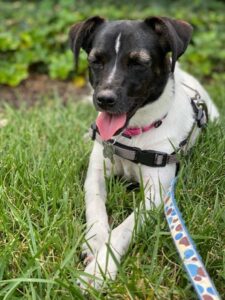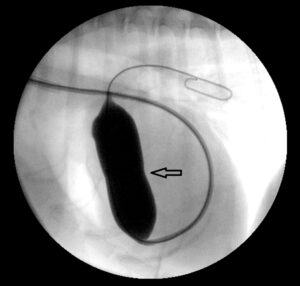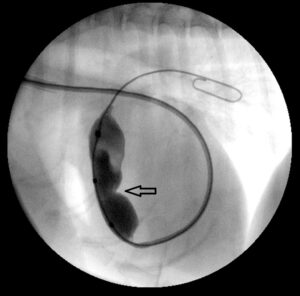 Meet Luna: A young Rat Terrier who presented to Friendship Hospital for Animals for evaluation of urinary issues with the Internal Medicine service. While being evaluated by Dr. Stephanie Skinner, a loud heart murmur was heard and Luna was referred to see our Board-Certified Veterinary Cardiologist, Dr. Chris McLaughlin.
Meet Luna: A young Rat Terrier who presented to Friendship Hospital for Animals for evaluation of urinary issues with the Internal Medicine service. While being evaluated by Dr. Stephanie Skinner, a loud heart murmur was heard and Luna was referred to see our Board-Certified Veterinary Cardiologist, Dr. Chris McLaughlin.
Dr. McLaughlin performed a heart ultrasound, called an echocardiogram. This technology allows us to see the inside structure of the heart, and look at blood flow within and between the heart chambers. On this exam, Luna was diagnosed with Pulmonary Valve Stenosis. This is one of the most common congenital heart defects in dogs, and it occurs when the valve between the right ventricle and the large blood vessel carrying blood to the lungs (the main pulmonary artery) does not develop properly. This results in a narrow opening in the pulmonary valve, creating an obstruction of blood flow to the lungs. As a result of this narrowing, the right ventricle needs to pump much more strongly, which it is not equipped to do. Over time, the right ventricle can become thick and eventually fail, leading to fluid accumulation in the body (called congestive heart failure), exercise intolerance and arrhythmias (abnormal heart beats). We know that dogs with severe pulmonary valve stenosis are at risk of these negative outcomes at a young age without intervention, so a pulmonary balloon valvuloplasty was recommended.
This interventional treatment of pulmonary stenosis involves catheterization of the heart under general anesthesia. A long catheter is usually fed through the jugular vein (the large vein of the neck) and into the right side of the heart. Usually, this type of surgery does not require any cutting, as everything is performed minimally invasively through a small needle poke in the neck. At the tip of this catheter is a long balloon. When inflated, the balloon dilates the pulmonary valve opening, stretching it to a more normal diameter. This procedure is generally successful at reducing the pressure gradient across the pulmonary valve to a mild to moderate range, and long-term prognosis following balloon valvuloplasty is generally quite good.


Luna had her surgery at Friendship with Dr. McLaughlin and Dr. Vitt. A picture of her heart with the balloon inflated over the pulmonary valve can be seen here. This first picture was taken at the beginning of balloon inflation, and you can easily see the narrowing (shown by the black arrow). The second picture shows the balloon fully inflated, with the narrowed opening being stretched open by the balloon. All went well with her surgery and her pulmonary valve is now functioning normally. She was able to go home the next day, with no incisions, and we expect Luna to have a long, normal and happy life!
If your pet is diagnosed with a heart murmur, please contact us to schedule an echocardiogram, especially if your pet is young. We want to diagnose and manage or treat heart disease at the earliest signs, to try and either slow the process or in some cases, like Luna’s, fix it altogether. Helping fix a puppy’s heart is one of the most gratifying parts of being a Veterinary Cardiologist!

Dr. Chris McLaughlin is originally from Woodstock, New Brunswick, Canada. He attended the Atlantic Veterinary College, followed by an Internship at the Ontario Veterinary College. He completed a residency in Emergency and Critical Care from North Carolina State University in 2016, before moving to South Florida to practice in two, large referral hospitals. During his time as a Director of Emergency and Critical Care, he developed a passion for minimally invasive interventional procedures. This led him to undertake a second residency in Cardiology at North Carolina State University, which he completed in July 2023.
